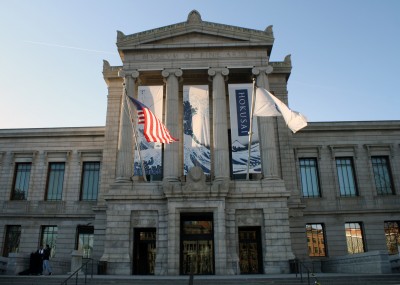
Three poppies bend in the wind. Their curvature mirrors Katsushika Hokusai’s widely known piece “The Great Wave,” displayed a few feet away at the Museum of Fine Arts. These delicate poppies are unnamed, save for the signature of 19th century artist Hokusai embossed on the corner of the light indigo print.
Like much of the work presented at these two new MFA exhibitions of Japanese art, the artist presents a unique perspective on nature. “Hokusai” features a range of the artist’s Edo-period work, while contemporary photography is presented in “In the Wake: Japanese Photographers Respond to 3/11.”
Toward the opposite end of the museum from Hokusai, a black-and-white photograph depicts a woman swathed in a kimono. She smirks at the camera, leaning against a white wall. Thick black lacerations stretch across the photo, giving the impression that she is snarled in cables. Above this visceral image is a photograph of sparse white clouds floating in the hazy black sky. Similar scratch marks stretch across the photograph.
Every morning, Nobuyoshi Araki went onto his balcony and photographed the sky, capturing the clouds and marking the date in the corner of each image. As the Fukushima nuclear disaster in Japan unfolded in March 2011, Araki went back to his collection of photographs — ranging from female eroticism to images of the sky — and scratched them with scissors to express his anger, pointing out that everything in life is no longer as it once was.
Araki, like the other 16 photographers featured in “In the Wake,” reveals a visual commentary of the tsunami, earthquake and nuclear disaster that shook the islands. The artists reincarnate this culmination of natural chaos, referred to as the “Triple Disaster” in the form of a hauntingly exquisite range of photographs.
Each photograph is making a statement, says curator Anne Havinga as she stands in front of a conceptual image by one of the youngest artists in the exhibit. When looked at closely, this depiction of a Fukushima power plant is created out of small coins of Japanese yen, emphasizing the damage caused by nuclear disaster to economic interests in nuclear power.
In a dark room in the exhibit, a miniscule daguerreotype hangs on a black wall. One of the first photo processes in the 19th century, the daguerreotype has recently been revived, in this case during the moment of the earthquake four years ago. Holding a piece of debris from a Bikini Atoll nuclear test, the photographer presents a nuclear theme of the disaster. The metal plate on the image is a small monument. Distant sounds echo in the darkness: “Earthquake. Get to higher ground!” The sound of public announcements during the disaster rings throughout the room.
Havinga explains that the “Hokusai” and “In the Wake” exhibitions are dually presented as a “Japan in Spring” theme, timed with the renovation of the MFA’s Japanese garden, which will be finished this month.
The Hokusai exhibit evokes Japanese tradition, from prints of ghost folklore to beautiful landscapes on fragile paper prints. Combining Hokusai’s refined work with creative photography, the dual exhibition tells a unique story of Japan’s past and present.
The exhibitions play off one another in subtle ways. Where there is sensibility in the delicate prints of Hokusai and chaos in the visual commentary of 3/11, there is a quiet, but powerful connection in both, enhancing each respective exhibition, and creating an emotive experience that enables viewers to peer into a more wholesome view of Japanese culture.
“Under the Wave off Kanagawa (Great Wave)” is one such shining star of Japanese art. Originally a woodcut of a tsunami from the Edo period, the Great Wave has become Hokusai’s most recognized work and has transcended into a global phenomenon — an Emoji on smart phones, the emblem for Quiksilver and probably inked on many an ankle. It is the grandiose poster in the MFA dining hall advertising the exhibition itself.
However, in the context of the exhibition, the wave takes on a different meaning. The imported Prussian blues and the serenity of the wave speak for a different perspective of Japanese nature, juxtaposed with destruction in “In the Wake.”
Surrounded by the many exquisite prints of Hokusai and in the similar context of the tsunami, the grandiose wave does not steal the show, but is in fact one of Hokusai’s many impressive pieces. His beautiful prints, along with the innovative photography, tell an ongoing story about the history of Japan and its resilience in the face of disaster.















Love it! Quite the raven! Beautiful insights! Keep it up
Definitely checking this out!
Great review of the exhibit. There are so many things that people should know about the culture of Japan, and it’s good that the exhibit is centering on that aspect. It would be interesting to see the picture that depicts the Fukushima power plant. Thanks for sharing your insight on the exhibit.